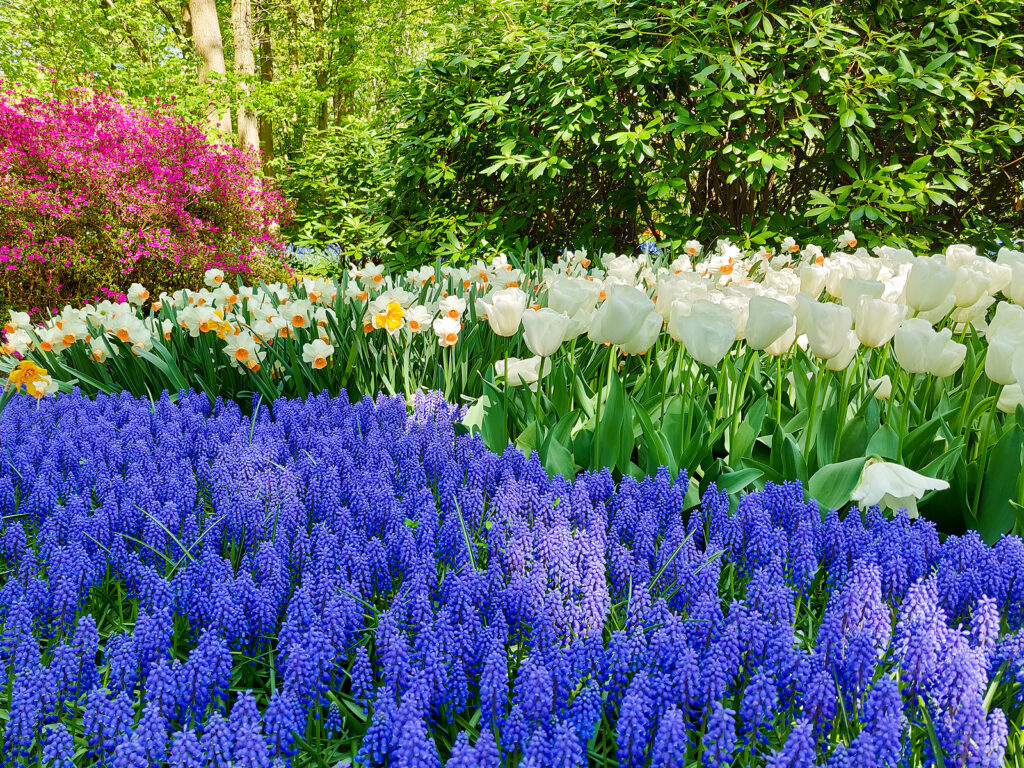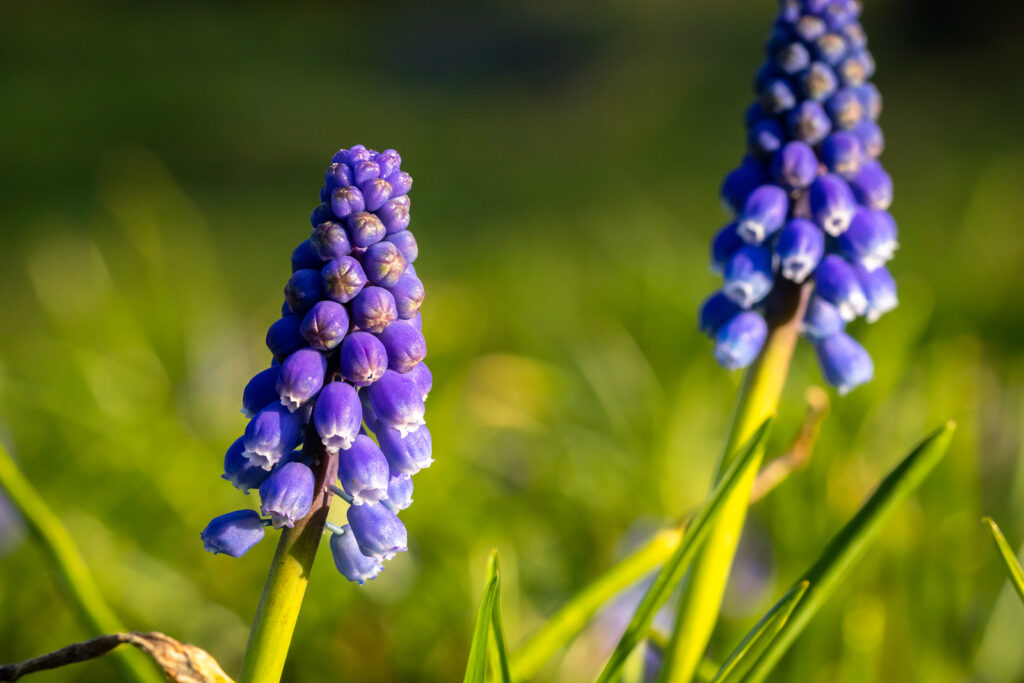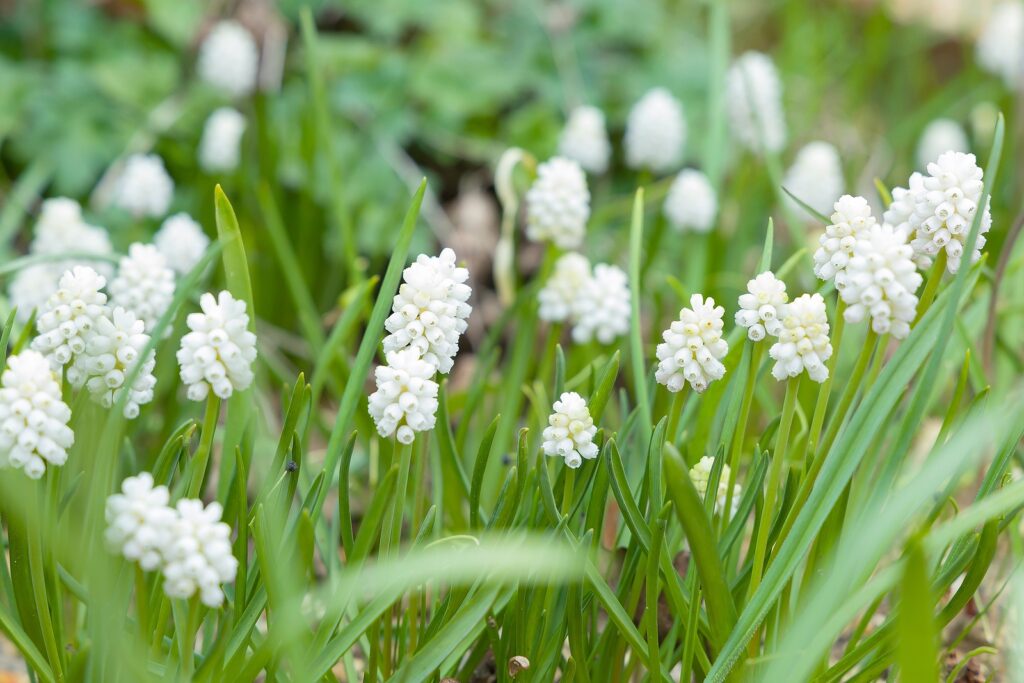Muscari–commonly called Grape hyacinth–is a spring-flowering perennial bulb with narrow grassy leaves and short spikes of small, fragrant, bell-shaped blue flowers held in cone-shaped clusters.
Muscari is often interplanted with other spring-blooming bulbs such as tulips and daffodils. Muscari, however, blooms about a month longer than other spring bulbs.
After plants bloom, the leaves yellow and disappear, but they appear again in fall and stay green through the winter in most regions.
Muscari are a colorful seasonal groundcover. They can be planted on slopes along with periwinkle. When the hyacinths finish blooming, the periwinkle begins to bloom and hides the hyacinths fading foliage.
Muscari is a genus of about 30 species of bulbous perennials native to the Mediterranean regions and Southwest Asia.

Get to know Muscari
- Plant type: Hardy spring-blooming bulb
- Growing Zones and range: Zones 5-8, Zone 4 with protection
- Hardiness: Half-hardy; requires cold winters, withstands summer heat
- Height and width: 6 to 12 inches (15-30cm) tall, 4 to 6 inches (10-15cm) wide
- Foliage: Fleshy leaves arranged in basal clusters are linear to inversely lance-shaped
- Flowers: Spikes bear small round flowers in clusters; clusters resemble an upside-down bunch of grapes. Colors are deep blue, light blue, pink, or white.
- Bloom time: Spring; blooms at the same time as tulips
- Uses: Woodland gardens, cut flower
- Common name: Grape Hyacinth
- Botanical name: Muscari spp.
- Family: Liliaceae
- Origin: Mediterranean region and Southwest Asia
Where to plant Muscari
- Plant Muscari in full sun or light shade.
- Grow Muscari in average to poor, well-drained soil that is preferably sandy.
- Muscari prefer a soil pH near 7 (neutral)

When to plant Muscari
- Plant Muscari bulbs in mid-autumn.
- Start seeds indoors from late winter to early spring; it takes 3 to 4 years for seedlings to mature enough to bloom.
- Sow seeds outdoors in early summer.
Planting and spacing Muscari
- Space Muscari bulbs and plants 4 to 6 inches (10-15cm) apart.
- Plant Muscari bulbs 2 to 3 inches (5-7.6cm) deep.
- For best effect, plant Muscari in groups of 3 to 4 dozen. Plants may spread on their own.
- Sow seed indoors in flats of six-packs; sow seed 1/8 inch deep. Seeds germinate in about 4 weeks.
- Sow seed outdoors in early summer or when seeds turn black and ripen on the plant. Scatter seed where you want them to naturalize.
How to water and feed Muscari
- Muscari like moderate water; keep the soil evenly moist. Do not overwater or bulbs may rot.
- Fertilize Muscari with bonemeal or all-purpose fertilizer at planting time. No fertilizer is needed in rich soil.

Muscari care
- Foliage will gradually fade after flowering. Do not cut the foliage; they help store nutrients in the bulbs or next season.
- Remove foliage when pulls away from the plant without resistance.
Growing Muscari as a houseplant
- Muscari armeniacum, M. azureum, and M. botryoides can be grown as houseplants.
- Muscari can be purchased in bloom or you can force your own bulbs if you chill then first.
- Pot the bulbs in the fall in a well-drained, soilless medium, with the tips of the bulbs just above the top of the medium.
- Store them outdoors in a dark cold frame for eight to 12 weeks before moving them inside.
- If the outdoor temperature does not drop to 40°F, the bulbs must be chilled in the refrigerator.
- Place pots in a room where the temperature is cool, humidity is average, and light is direct.
- Keep the medium evenly moist.
- After the flowers have faded, discard the bulbs or plant them outdoors to bloom the next year.
Muscari pests and diseases
- Muscari is usually pest-free.
- Muscari can be prone to viruses.
Muscari propagation
- Remove offsets in summer and replant.
- Dig up and separate crowded plants after they bloom, when foliage starts to yellow.
- After lifting a clump, separate the bulbs gently by hand then reset immediately.
Muscari varieties to grow
- Muscari armeniacum. Grows to 9 inches tall; small oblong flowers are deep blue to deep violet with white edges; cultivar ‘Blue Spike’ has dense double flower clusters.
- M. azureu. Grows to 8 inches tall; small blue flowers; cultivars ‘Album’ has white flowers; ‘Amphibolis’ has light blue flowers.
- M. botryoides. Grows to 12 inches tall; tiny round flwoers are blue with white edges; cultivars ‘Album’ has white flowers; ‘Caeruleum’ has bright blue flowers; ‘Carneum’ has pale pink flowers.
- M. comosum, tassel grape hyacinth. Grows to 18 inches (45cm) tall; has leathery flowers .















